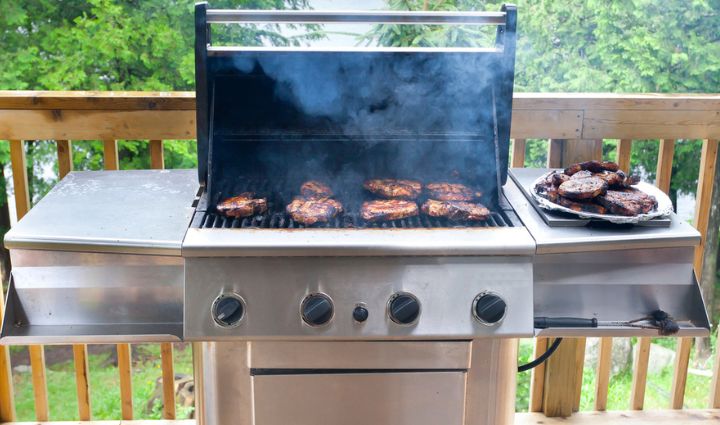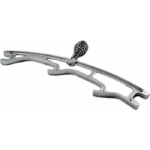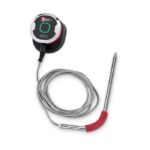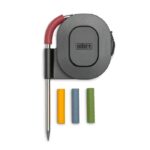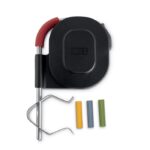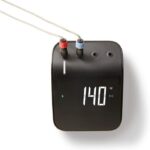To close or not to close? It may seem like a simple question, but whether or not you should be grilling with the lid open is one many home cooks struggle to answer.
Like all things grilling, there’s no straightforward rule to follow when it comes to grilling with the lid open. Ultimately, whether you leave the lid open or closed depends on three main factors:
- What you’re grilling. Thinner, smaller items typically call for an open lid, while thicker cuts of meat or things you need to cook slower call for a closed lid. More on this later.
- The size and type of grill you have. Charcoal grilling almost always calls for a closed lid. With a gas grill, on the other hand, grilling with the lid open or closed primarily depends on what exactly you’re cooking.
- The weather. If it’s cold outside, raining, or very windy, you will definitely want a closed lid to retain as much heat as possible (and keep your cookout from getting washed out).
In this post, we’ll dig into the “lid open or closed” debate to help you understand when you should be grilling with the lid open and when it should be shut, including gas grilling with the lid open and when to close the lid on a charcoal grill.
Let’s get cooking.
Gas Grilling With The Lid Open or Closed
As a general rule for gas grilling, an open lid is ideal for fast cooking over high heat, while a closed lid is ideal for slower cooking over lower heat. Here’s why:
- Closing the lid traps heat inside your grill and creates convection, which means your barbecue will function more like an oven than a grill. This setup is ideal when you want to bake something (yes, you can bake in the barbecue!), or when you’re cooking something larger or thicker and need to ensure it’s evenly cooked all the way through.
- If you’re looking for that perfect sear, or are grilling something thin or which cooks quickly, leaving the lid open (and the heat high) will help you achieve a delicious charred crust without overcooking the center of whatever you’re grilling.
There are also times when you’ll want to use both techniques to achieve that delicious blend of seared, caramelized crust with a juicy, perfectly-cooked middle. In this case, you’ll use a two-zone heat method and sear with the lid open over direct heat, then move your food to the indirect heat zone, shut the lid, and let the center cook through. You can also reverse this process if you prefer the reverse sear technique.
Learn more about direct vs. indirect grilling methods.
When should you use a grill lid prop?
Sometimes, you may want to leave your grill lid open just a bit to let smoke escape or let some heat out without losing all of it. Leaving the lid open a crack can be helpful when you’re:
- Rotisserie grilling, especially on smaller BBQs
- Using a smoker box to vent excess smoke and prevent oversmoking your food
- Slow cooking to control the temperature
A grill lid prop is designed to hold your grill lid partially open so you don’t have to stand over a hot grill holding a heavy lid. With three height settings, you can prop your lid open as much as needed to keep heat in while letting smoke out, allowing for finer temperature control and easier air flow adjustments.
Shop lid props:
Gas Grilling With The Lid Open vs. Lid Closed Comparison Chart
Still not sure whether you should be gas grilling with the lid open or closed? Check out our quick reference chart:
Lid Open
- Burgers
- Thinner steaks
- Hot dogs
- Shrimp and other small things that can overcook easily
- Anything less than ¾” thick
- Thinner vegetables like slices of zucchini or eggplant, asparagus, mushrooms
- Fish where you want a hard sear but a rare center (salmon or tuna)
Lid Closed
- Preheating the grill
- Indirect cooking
- Whole chickens
- Smoking with a smoker box
- Large pieces of meat— anything over ¾” thick
- Anything “low and slow”
- Rotisserie grilling
- Larger vegetables like broccoli, cauliflower, or corn on the cob
- Anything baked
Combination
- Thicker steaks and chops
- Thicker burgers
- Raw sausages
- Bone in chicken
- Fish steaks
When To Close the Lid on a Charcoal Grill
When it comes to the “lid open or closed” conundrum, charcoal grilling is much simpler. Once the coals are lit and arranged, you will pretty much always want to leave the lid closed on a charcoal grill.
While lifting the lid too often on a gas grill lets the heat escape, it has the opposite effect on a charcoal grill—opening the lid allows more oxygen to reach the coals, which means they’ll burn even hotter.
It’s okay to open the lid periodically to check progress, but try to keep it closed as much as possible, especially if you’re grilling larger cuts over indirect heat. A probe thermometer or smart grilling hub can help you monitor doneness without opening the lid. If you need to adjust the air flow to control the temperature for indirect cooking, you can open the air vents to allow more air to pass through.
Shop for Smart grilling thermometers:
Wrapping Up
Whether you grill with the lid open or closed ultimately depends on what you’re grilling, what kind of BBQ you have, and the weather. As a general rule, leave the lid open for searing and grilling items that cook quickly, and shut it if you have a charcoal grill or are cooking something thicker on a gas grill.
In some cases, you will want to use a hybrid approach, and you may even want to prop your grill lid open a bit to let smoke out but keep heat in. A grill lid prop is a key tool for improving temperature control, and a probe thermometer can help limit how often you need to open the lid to check the doneness of whatever you’re cooking.

